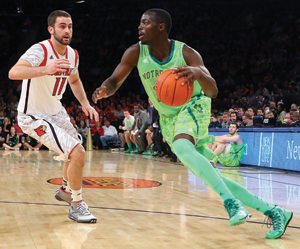“What does March Madness exposure do to our school’s brand?”
Long before Selection Sunday, how often has this question come up in conversations between a college president, the athletic director and the basketball coaches? How does the present and future value of the college’s brand enter into the discussion when there are influences (networks, uniform suppliers, recruiting, alumni, etc.) providing a path to significant and welcome nontuition revenue?
Overall, the business of colleges is under attack. Higher operating costs, increased employee benefits and pressure to lower the cost of a college education are everyday realities on the quad. And the competition among schools for tuition dollars gets fiercer. Given that, brand management is more important than ever, and shaping and sharpening brand messages that differentiate and drive enrollment are getting plenty of scrutiny these days.
At the same time, college athletics is also under attack: Athletes, athletics programs and conference geography seem to make headlines on a daily basis for all the wrong reasons. So participation in this annual rite of spring would appear to be a welcome opportunity for colleges to present themselves (aka their brands) in a strategic and thoughtful manner. Coaches, student athletes, mascots, cheerleaders, bands and fans are all brand representatives and provide the chance to put the best brand forward to a large and engaged audience. You’re on the Big Dance hardwood, so get it right.
But looking at how some of these schools are dressed, you wonder how many colleges are paying attention to their brands during this significant, made-for-TV event that, in 2012 according to Nielsen, was seen by more than 57 million viewers. And that’s not counting the collateral media, social media and bracket buzz that surround this national event. A scan of the colleges and their brand “dress” at the Big Dance provides three categories of brand management that are most prevalent.
 |
The Notre Dame-Louisville Big East game was great for Adidas but did little for the schools’ brands.
Photo: GETTY IMAGES
|
The big three uniform suppliers lock up the rights to the nation’s elite basketball programs by providing product and, for a select few schools, cash. The suppliers use tournament time and its media exposure to show off new looks and fabric technologies, sometimes at the cost of hijacking or diluting a school’s core brand attributes and presenting a confusing or inconsistent message about the school itself.
For example, this year, Adidas developed a short-sleeved jersey that recently made its NBA debut with Golden State, and put a handful of its schools in the new technology threads for postseason play. But it seems that just the short sleeves weren’t enough to distinguish the improved performance aspects of the uniform, so late-1980s/early-’90s inspired shorts were added to the look. During the recent Big East tournament, Notre Dame ended up wearing something that looks like it came out of Gumby’s closet and played Louisville in the all-Adidas, all-camo, all-ugly semifinal. This matchup was great for the supplier but did little to benefit the schools’ presentations.
Other schools take to wearing the latest and greatest fads such as “blackout” uniforms that have no place in the brand dress of the athletics style guide and tend to create brand confusion and more sloppy brand management. Never mind that black is not a brand color for about 70 percent of the teams participating in the NCAA tournament. Is a short-term fashion fad in exchange for a quick return worth compromising the school’s long-term brand? Does the cost-benefit analysis pay out for the school or the uniform supplier? If a school or supplier wants to add an alternate look, it should at least give some consideration to doing a TV test so that names and numbers are legible to the game’s much larger television audience.
Many schools have established a balance between athletics success, academic excellence and overall reputation in the strategic vision of the institution. “It’s always interesting to see how these trends play out, but there’s not a right or a wrong when it comes to uniform looks,” said Steve Malchow, Iowa State’s senior associate athletic director for communications. “From our point of view, it’s most important that our brand’s presentation be applied in a consistent manner.”
Classic brands such as Indiana have opted out of the Adidas short-sleeved, technocamo-inspired program. In fact, except for the length of the shorts, it does not appear that much has changed in the Hoosiers’ on-court look since Bob Knight was coaching them to NCAA titles in the ’70s and ’80s.
Others manage their brand in a similar fashion. “We are always looking to evolve, adapt and change with our students, fans, athletes and stakeholders, but within the context of the Sooners brand,” said Charlie Taylor, Oklahoma’s assistant athletics director for marketing. “March Madness provides extended brand relevance for our teams as well as a great platform for recruiting.”
Beyond recruiting, it’s well-documented that schools appearing in the Big Dance see an increase in overall applications and test scores, which provides the opportunity to fulfill strategic and national admissions goals. All the more reason to pay attention to how each aspect of the school’s message is presented, including what you’re wearing. March Madness remains a vital and important part of the college experience and the college brand at many schools, so it’s critical that administrators, athletic directors and coaches “be true to the school” and manage its image and messaging in a consistent, sustainable and visionary manner at this time.
When it comes to leveraging this asset, college presidents, senior administrators and athletic directors should ask, “How do we want our greatest earned media exposure to best represent our institution?”
David Haney (David@JoeBosack.com) is managing director at Joe Bosack & Co., a brand consulting and design agency. Follow him on Twitter @DFHaney and @JBosack.





